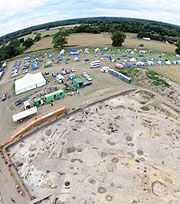University has leading part in The Eagle movie
Release Date 22 March 2011

University of Reading research has shed new light on the mysterious Roman artefact starring in this spring's blockbuster movie, The Eagle.
In 1866 while excavating the principal public building of the Roman town of Calleva, near Silchester, the Revd James Joyce discovered the remains of a spectacular bronze eagle. Revd Joyce believed the eagle to once be the imperial standard of a Roman legion that was hidden when the legion was attacked, its owners desperate not to let their treasure fall in to enemy hands.
Upon seeing the eagle in Reading Museum, where the artefact is still kept today, Rosemary Sutcliffe used this interpretation of the bird as an imperial standard to write the wonderful book ‘The Eagle of the Ninth', first published in 1954. Joyce's speculation about how it came to its final resting place was later used in her ‘The Silver Branch' published in 1957.
Nineteenth century excavation of the site where the eagle was first found suggested it was part of a statue that stood in the town's great second-century town hall, which burnt down in the third century. However, new research undertaken at Silchester by leading archaeologist and University of Reading Professor Michael Fulford, strongly suggests that the bronze bird stood in the royal palace of the native British King that ruled that part of Britain on behalf of the Roman Empire, long before the Romano-British town hall was built.
Professor Fulford said: "A combination of accumulated knowledge and close study have shown the eagle was almost certainly part of a statue of the Roman god Jupiter and not part of a legionary standard. It's likely that the Romans gave the statue to the local ruler who ruled this part of southern Britain on behalf of Rome. The probable donor was Nero himself as it was he who ordered the construction of the palace for his tribal ally."
At some stage the palace's eagle suffered substantial damage. So important to the local ruler was the eagle, he had it repaired. Once fixed, it probably continued to reside in the royal palace until the building was destroyed, either by accidental fire or during renewed unrest, probably sometime in the 80s AD. During that mysterious destruction, the eagle was buried under the rubble of the palace, which ended up as part of the ‘hardcore' platform on which Silchester's Roman town hall was built.
Ends
For all University of Reading media enquiries please contact James Barr, Press Officer.
Tel: 0118 378 7115 or email: j.w.barr@reading.ac.uk
Notes for Editors:
The University of Reading's Department of Archaeology boasts five Fellows of the British Academy among its members and was recognised in 2010 when the University was awarded the Queen's Anniversary Prize for Higher Education. In the most recent Research Assessment Exercise (2008), the department was ranked as the UK archaeology department with the highest proportion of world-leading research (40% 4* research).
The Department's six core areas of research cover the entirety of human history in Europe and the Near and Middle East from the last glaciation to AD1600. The world-leading research areas have a direct relevance for contemporary environmental and climatic change and in which the five Fellows of the British Academy play a major role. They include: the development of the first complex societies in the Near and Middle East since the last glaciation (Prof Steve Mithen FBA); coastal and wetland archaeology and the relationship between humans and the environment in prehistory (Prof Martin Bell FBA); later prehistoric societies in north-west Europe (Prof Richard Bradley FBA); urbanisation in the Roman World (Prof Michael Fulford FBA); Digital Data Capture in the Field, Database Development and Digital Dissemination World (Prof Michael Fulford FBA) and the archaeology of medieval gender, religion and belief (Prof Roberta Gilchrist FBA).